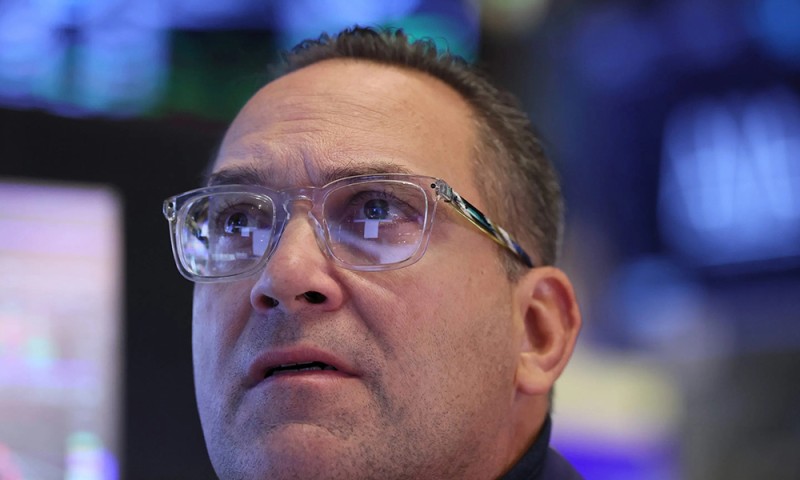
双线资本(DoubleLine Capital)创始人兼首席执行官杰弗里·冈拉克(Jeffrey Gundlach)对当前投资格局给出了惊人评估,他认为美国股市正深陷一场“狂热”,同时指出黄金是主要的避风港,并将其提升至“真正的资产类别”的地位。
这位“债券之王”上周一在彭博社的《Odd Lots》播客节目中表示,美国股市是他整个职业生涯中见过的“最不健康的市场之一”。他引用了市盈率和市值比率等指标,指出“所有经典的估值指标都已爆表”。
这位亿万富翁投资者断言,“我们正处于一场狂热之中,这是无可争辩的事实”,并将当前对人工智能的热情比作先前对电力等的狂热。但他指出,电力股在1911年达到顶峰,此后再未恢复,远在电力商业化普及之前。他警告说,尽管像电力这样的变革性技术改变了世界,但市场往往会“非常迅速且过度地”将未来收益定价。他表示,投资者在狂热时期需要“非常谨慎地对待动量投资”。冈拉克称,他认为市场“极具投机性”,而投机市场不可避免地会“达到疯狂的高位”。
黄金:配置真正价值的资产
在高金融资产估值的背景下,冈拉克已将焦点转向硬资产,特别推崇黄金。他表示自己一直“非常、非常看好黄金”,并且这是他“今年最看好的首选”。
冈拉克表示,他认为黄金已经在严谨的投资组合中巩固了地位,因为它现在被视为一种“真正的资产类别”。关键在于,对黄金的需求不再局限于“生存主义者”或“疯狂的投机者”。相反,人们正在配置“真金白银,因为它具有真实价值”。
黄金作为“今年表现最佳的资产,当然也是过去12个月表现最佳的资产”,印证了这一观点。尽管黄金似乎在高位盘整,冈拉克仍建议维持一定的配置比例,大约占投资组合的15%——不再是25%——因为其涨势似乎已部分兑现。
一些长期对黄金持怀疑态度的人士已经转变了看法,例如摩根大通(JPMorgan)首席执行官杰米·戴蒙(Jamie Dimon)。他在10月告诉《财富》杂志总编辑艾莉森·尚泰尔(Alyson Shontell),这是他“一生中为数不多的几次认为在投资组合中配置一些黄金具有一定合理性”的时候之一。
他补充说:“在这样的环境下,(金价)很容易达到5000美元或10000美元。”(戴蒙发表此番言论后不久,金价就进入了平台期,尽管在本文发稿时金价仍略高于每盎司4000美元。)
其他长期关注股市的人士也表示,当前市场不确定性太大,投资者应考虑另类资产。例如,纽约大学(NYU)金融学教授阿斯沃斯·达莫达兰(Aswath Damodaran)本周告诉他的老同事斯科特·加洛韦(Scott Galloway),“收藏品”,甚至是棒球卡,在当下都是一项理性的投资。“如果你想把你的一部分钱投入棒球卡,因为你真的对棒球卡做过研究,那我有什么资格插手说那不是放钱的好地方呢?”
投资组合的激进转变
考虑到极端投机和市场范式转变的双重现实,冈拉克建议投资者大幅减少对传统金融资产的敞口。他认为,传统的60/40投资组合(股票/债券)应该进行大幅调整。
他说:“我认为,广义的金融资产……配置比例应该低于通常水平。”投资者不应将100%的资产配置于金融资产,股票最多应占40%,他建议固定收益资产只应占投资组合的25%左右。由于市场估值“高得难以置信”,他倾向于将剩余部分配置于黄金等实物资产并持有现金。
冈拉克发表上述评论之前的一周,包括英伟达(Nvidia)在内的多家大公司即将公布财报,市场对该领域存在泡沫的担忧日益加剧。过去一个月,标准普尔500指数下跌了1.45%,但达莫达兰警告加洛韦,他认为市场尚未对重大经济衰退的风险进行定价。他表示,或许比过去20年中的任何时候都更有可能发生一场”潜在灾难性的市场和经济危机“,风险显著。同样在周一,美国银行研究部(Bank of America Research)发布了其全球基金经理调查,结果显示,二十年来首次,代表5500亿美元管理资产的大部分受访者担心企业过度投资,其中45%的人表示”AI泡沫是最大的尾部风险。(*)
译者:郝秀
审校:汪皓
双线资本(DoubleLine Capital)创始人兼首席执行官杰弗里·冈拉克(Jeffrey Gundlach)对当前投资格局给出了惊人评估,他认为美国股市正深陷一场“狂热”,同时指出黄金是主要的避风港,并将其提升至“真正的资产类别”的地位。
这位“债券之王”上周一在彭博社的《Odd Lots》播客节目中表示,美国股市是他整个职业生涯中见过的“最不健康的市场之一”。他引用了市盈率和市值比率等指标,指出“所有经典的估值指标都已爆表”。
这位亿万富翁投资者断言,“我们正处于一场狂热之中,这是无可争辩的事实”,并将当前对人工智能的热情比作先前对电力等的狂热。但他指出,电力股在1911年达到顶峰,此后再未恢复,远在电力商业化普及之前。他警告说,尽管像电力这样的变革性技术改变了世界,但市场往往会“非常迅速且过度地”将未来收益定价。他表示,投资者在狂热时期需要“非常谨慎地对待动量投资”。冈拉克称,他认为市场“极具投机性”,而投机市场不可避免地会“达到疯狂的高位”。
黄金:配置真正价值的资产
在高金融资产估值的背景下,冈拉克已将焦点转向硬资产,特别推崇黄金。他表示自己一直“非常、非常看好黄金”,并且这是他“今年最看好的首选”。
冈拉克表示,他认为黄金已经在严谨的投资组合中巩固了地位,因为它现在被视为一种“真正的资产类别”。关键在于,对黄金的需求不再局限于“生存主义者”或“疯狂的投机者”。相反,人们正在配置“真金白银,因为它具有真实价值”。
黄金作为“今年表现最佳的资产,当然也是过去12个月表现最佳的资产”,印证了这一观点。尽管黄金似乎在高位盘整,冈拉克仍建议维持一定的配置比例,大约占投资组合的15%——不再是25%——因为其涨势似乎已部分兑现。
一些长期对黄金持怀疑态度的人士已经转变了看法,例如摩根大通(JPMorgan)首席执行官杰米·戴蒙(Jamie Dimon)。他在10月告诉《财富》杂志总编辑艾莉森·尚泰尔(Alyson Shontell),这是他“一生中为数不多的几次认为在投资组合中配置一些黄金具有一定合理性”的时候之一。
他补充说:“在这样的环境下,(金价)很容易达到5000美元或10000美元。”(戴蒙发表此番言论后不久,金价就进入了平台期,尽管在本文发稿时金价仍略高于每盎司4000美元。)
其他长期关注股市的人士也表示,当前市场不确定性太大,投资者应考虑另类资产。例如,纽约大学(NYU)金融学教授阿斯沃斯·达莫达兰(Aswath Damodaran)本周告诉他的老同事斯科特·加洛韦(Scott Galloway),“收藏品”,甚至是棒球卡,在当下都是一项理性的投资。“如果你想把你的一部分钱投入棒球卡,因为你真的对棒球卡做过研究,那我有什么资格插手说那不是放钱的好地方呢?”
投资组合的激进转变
考虑到极端投机和市场范式转变的双重现实,冈拉克建议投资者大幅减少对传统金融资产的敞口。他认为,传统的60/40投资组合(股票/债券)应该进行大幅调整。
他说:“我认为,广义的金融资产……配置比例应该低于通常水平。”投资者不应将100%的资产配置于金融资产,股票最多应占40%,他建议固定收益资产只应占投资组合的25%左右。由于市场估值“高得难以置信”,他倾向于将剩余部分配置于黄金等实物资产并持有现金。
冈拉克发表上述评论之前的一周,包括英伟达(Nvidia)在内的多家大公司即将公布财报,市场对该领域存在泡沫的担忧日益加剧。过去一个月,标准普尔500指数下跌了1.45%,但达莫达兰警告加洛韦,他认为市场尚未对重大经济衰退的风险进行定价。他表示,或许比过去20年中的任何时候都更有可能发生一场”潜在灾难性的市场和经济危机“,风险显著。同样在周一,美国银行研究部(Bank of America Research)发布了其全球基金经理调查,结果显示,二十年来首次,代表5500亿美元管理资产的大部分受访者担心企业过度投资,其中45%的人表示”AI泡沫是最大的尾部风险。(*)
译者:郝秀
审校:汪皓
Jeffrey Gundlach, founder and CEO of DoubleLine Capital, has delivered a striking assessment of the current investment landscape, arguing the U.S. equity market is engulfed in a “mania” while simultaneously identifying gold as the primary refuge, elevating the metal to the status of a “real asset class.”
The “Bond King” told Bloomberg's Odd Lots podcast on Monday the U.S. equity market is “among the least healthy” he's seen in his entire career. Citing metrics such as the price-to-earnings (PE) ratio and the cap ratio, he noted “all the classic valuation metrics are off the charts.”
The billionaire investor asserted there is “no argument against the fact that we're in a mania,” likening the enthusiasm for artificial intelligence (AI) to previous manias about, for instance, electricity---except he noted electricity stocks peaked in 1911 and never recovered afterward, far before commercial implementation. He cautioned that while transformative technologies like electricity were world-changing, the market tends to price in the future benefits “very quickly and excessively.” He said investors need to be “very careful about momentum investing during, mania periods.” Gundlach said he sees the market as “incredibly speculative” and speculative markets inevitably “go to insanely high levels.”
Gold: The allocation for real value
Against the backdrop of high financial asset valuations, Gundlach has shifted his focus toward hard assets, specifically championing gold. He noted he has been “very, very bullish on gold” and it was his “number one best idea for this year.”
Gundlach said he believes gold has cemented its place in serious portfolios because it's now treated as a “real asset class.” Crucially, the demand for gold is no longer limited to “survivalists” or “crazy speculators.” Instead, people are allocating “real money because it's real value.”
Gold has validated this belief by being the “top performing asset, for the year, certainly for the last 12 months.” Although gold seems to be consolidating at high levels, Gundlach still suggests maintaining an allocation, perhaps around 15% of a portfolio---no longer 25%---because it appears to have played out somewhat.
Some longtime skeptics on gold have come around on it, such as JPMorgan CEO Jamie Dimon, who told Fortune editor-in-chief Alyson Shontell in October it was “one of the few times in my life it's semi-rational to have some in your portfolio.”
It could easily go to $5,000 or $10,000 in environments like this,“ he added. (Dimon's comments came shortly before a plateau in the price, although it remains slightly over $4,000 per ounce at press time.)
Other long-time equities-focused voices are saying the current market is so uncertain investors should consider alternative assets. NYU Finance Professor Aswath Damodaran, for instance, told his longtime colleague Scott Galloway this week ”collectibles,“ even baseball cards, are a rational investment at the moment. ”If that's where you want to put some of your money into is baseball cards, because you've truly done your work on baseball cards, who am I to step in and say that's not a great place to put your money?“
Radical portfolio shift
Given the dual realities of extreme speculation and changing market paradigms, Gundlach advised investors to dramatically reduce their exposure to traditional financial assets. He argued the traditional 60/40 portfolio (equities/bonds) should be drastically adjusted.
”I think financial assets broadly should ... have a lower allocation than typical,“ he said. Instead of 100% financial assets, investors should have a maximum of 40% in equities, and he recommends fixed income should only account for about 25% of a portfolio. He prefers allocating the remainder to real assets like gold and holding cash due to the ”incredibly high“ valuations across markets.
Gundlach's comments came ahead of a week with major earnings set to be disclosed, including Nvidia, with mounting concerns over a bubble in that space. The S&P 500 is down 1.45% over the past month, but Damodaran warned Galloway he believes the market is not pricing in the risk of a major downturn. He said that, perhaps more than any time in the last 20 years, there's a significant risk of a ”market and economic crisis that is potentially catastrophic.“ Also on Monday, Bank of America Research released its global fund manager survey, which found, for the first time in two decades, a majority of the panelists representing $550 billion in assets under management were concerned companies had overinvested, with 45% of them saying ”AI bubble“ was the largest tail risk.

